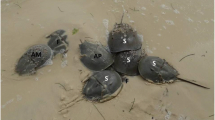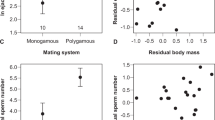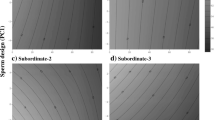Abstract
Sperm competition is widespread among animal taxa and considered a major force in sperm evolution. Recent comparative studies have indicated that sperm competition selects for high sperm production capacity and long and fast-swimming spermatozoa across species. Here, we examine the role of sperm quantity and quality for fertilization success of individual males in a Canadian population of tree swallows Tachycineta bicolor, a socially monogamous, but highly promiscuous passerine. Male fertilization success (the sum of withinpair and extrapair young) was significantly associated with the size of the cloacal protuberance (a proxy for sperm quantity), but not with sperm size or in vitro sperm swimming speed. In a multivariate analysis, both cloacal protuberance volume and relative sperm midpiece size (i.e. high mitochondrial loading) had significant effects on male fertilization success. However, relative sperm midpiece size was not associated with fertilization success in a simple regression. Further, both cloacal protuberance volume and relative midpiece size had significant effects on sperm velocity, both in simple regressions and in a multivariate analysis. The finding that males with large relative midpiece size had both higher fertilization success and faster swimming sperm, suggests an indirect link between sperm morphology and male fertility mediated through sperm velocity. In conclusion, both quantitative and qualitative sperm traits seem to affect male fertilization success in tree swallows.




Similar content being viewed by others

References
Birkhead TR, Møller AP (1998) Sperm competition, sexual selection and different routes to fitness. In: Birkhead TR, Møller AP (eds) Sperm competition and sexual selection. Academic Press, London, pp 757–781
Birkhead TR, Pizzari T (2002) Post-copulatory sexual selection. Nat Rev Genet 3:262–273
Birkhead TR, Briskie JV, Møller AP (1993) Male sperm reserves and copulation frequency in birds. Behav Ecol Sociobiol 32:85–93
Birkhead TR, Buchanan KL, Devoogd TJ, Pellatt EJ, Szekely T, Catchpole CK (1997) Song, sperm quality and testes asymmetry in the sedge warbler. Anim Behav 53:965–971
Birkhead TR, Martinez JG, Burke T, Froman DP (1999) Sperm mobility determines the outcome of sperm competition in the domestic fowl. Proc R Soc B 266:1759–1764
Bitton P-P, O'Brien EL, Dawson RD (2007) Plumage brightness and age predict extrapair fertilization success of male tree swallows, Tachycineta bicolor. Anim Behav 74:1777–1784
Briskie JV, Montgomerie R (1992) Sperm size and sperm competition in birds. Proc R Soc B 247:89–95
Briskie JV, Montgomerie R, Birkhead TR (1997) The evolution of sperm size in birds. Evolution 51:937–945
Calhim S, Immler S, Birkhead TR (2007) Postcopulatory sexual selection is associated with reduced variation in sperm morphology. PLoS ONE 2:e413
Cardullo RA, Baltz JM (1991) Metabolic regulation in mammalian sperm: mitochondrial volume determines sperm length and flagellar beat frequency. Cell Motil Cytoskelet 19:180–188
Casselman SJ, Schulte-Hostedde AI, Montgomerie R (2006) Sperm quality influences fertilization success in the walleye (Sander vitreus). Can J Fish Aquat Sci 63:2119–2125
Crowe SA, Kleven O, Delmore KE, Laskemoen T, Nocera JJ, Lifjeld JT, Robertson JR (2009) Paternity assurance through frequent copulations in a wild passerine with intense sperm competition. Anim Behav 77:183–187
Delmore KE, Kleven O, Laskemoen T, Crowe SA, Lifield JT, Robertson JR (2008) Sex allocation and parental quality in tree swallows. Behav Ecol 19:1243–1249
Denk AG, Kempenaers B (2006) Testosterone and testes size in mallards (Anas platyrhynchos). J Ornithol 147:436–440
Denk AG, Holzmann A, Peters A, Vermeirssen ELM, Kempenaers B (2005) Paternity in mallards: effects of sperm quality and female sperm selection for inbreeding avoidance. Behav Ecol 16:825–833
Deviche P, Wingfield JC, Sharp PJ (2000) Year-class differences in the reproductive system, plasma prolactin and corticosterone concentrations, and onset of prebasic molt in male dark-eyed juncos (Junco hyemalis) during the breeding period. Gen Comp Endocrinol 118:425–435
Dickinson JL (2001) Extrapair copulations in western bluebirds (Sialia mexicana): female receptivity favors older males. Behav Ecol Sociobiol 50:423–429
Donoghue AM, Sonstegard TS, King LM, Smith EJ, Burt DW (1999) Turkey sperm mobility influences paternity in the context of competitive fertilization. Biol Reprod 61:422–427
Dunn PO, Cockburn A (1999) Extrapair mate choice and honest signaling in cooperatively breeding superb fairy-wrens. Evolution 53:938–946
Dunn PO, Whittingham LA, Pitcher TE (2001) Mating systems, sperm competition, and the evolution of sexual dimorphism in birds. Evolution 55:161–175
Dunn PO, Lifjeld JT, Whittingham LA (2009) Multiple paternity and offspring quality in tree swallows. Behav Ecol Sociobiol 63:911–922
Eberhard WG (1996) Female control: sexual selection by cryptic female choice. Princeton University Press, Princeton
Eisenbach M, Giojalas LC (2006) Sperm guidance in mammals—an unpaved road to the egg. Nat Rev Mol Cell Biol 7:276–285
Evans MR, Goldsmith AR (2000) Male wrens with large testes breed early. Anim Behav 60:101–105
Fitzpatrick JL, Montgomerie R, Desjardins JK, Stiver KA, Kolm N, Balshine S (2009) Female promiscuity promotes the evolution of faster sperm in cichlid fishes. Proc Natl Acad Sci USA 106:1128–1132
Gage MJG (1998) Mammalian sperm morphometry. Proc R Soc B 265:97–103
Gage MJG, Macfarlane CP, Yeates S, Ward RG, Searle JB, Parker GA (2004) Spermatozoal traits and sperm competition in Atlantic salmon: relative sperm velocity is the primary determinant of fertilization success. Curr Biol 14:44–47
Garamszegi LZ, Eens M, Hurtrez-Boussès S, Møller AP (2005) Testosterone, testes size, and mating success in birds: a comparative study. Horm Behav 47:389–409
Gomendio M, Roldan ERS (2008) Implications of diversity in sperm size and function for sperm competition and fertility. Int J Dev Biol 52:439–447
Graves GR (2004) Testicular volume and asymmetry are age-dependent in black-throated blue warblers (Dendroica caerulescens). Auk 121:473–485
Helfenstein F, Szép T, Nagy Z, Kempenaers B, Wagner RH (2008) Between-male variation in sperm size, velocity and longevity in sand martins Riparia riparia. J Avian Biol 39:649–652
Helfenstein F, Podevin M, Richner H (2010) Sperm morphology, swimming velocity, and longevity in the house sparrow Passer domesticus. Behav Ecol Sociobiol 64:557–565
Hilton FK (1968) Endocrine control of seminal-glomus growth and function in starlings of different ages. Physiol Zool 41:364–370
Humphries S, Evans JP, Simmons LW (2008) Sperm competition: linking form to function. BMC Evol Biol 8:319
Immler S, Birkhead TR (2007) Sperm competition and sperm midpiece size: no consistent pattern in passerine birds. Proc R Soc B 274:561–568
Immler S, Saint-Jalme M, Lesobre L, Sorci G, Roman Y, Birkhead TR (2007) The evolution of sperm morphometry in pheasants. J Evol Biol 20:1008–1014
Immler S, Calhim S, Birkhead TR (2008) Increased postcopulatory sexual selection reduces the intramale variation in sperm design. Evolution 62:1538–1543
Johnsen A, Lifjeld JT, Andersson S, Örnborg J, Amundsen T (2001) Male characteristics and fertilisation success in bluethroats. Behaviour 138:1371–1390
Kempenaers B, Everding S, Bishop C, Boag P, Robertson RJ (2001) Extra-pair paternity and the reproductive role of male floaters in the tree swallow (Tachycineta bicolor). Behav Ecol Sociobiol 49:251–259
Kempenaers B, Peer K, Vermeirssen ELM, Robertson RJ (2002) Testes size and asymmetry in the tree swallow Tachycineta bicolor: a test of the compensation hypothesis. Avian Sci 2:115–122
Kleven O, Marthinsen G, Lifjeld JT (2006) Male extraterritorial forays, age and paternity in the socially monogamous reed bunting (Emberiza schoeniclus). J Ornithol 147:468–473
Kleven O, Laskemoen T, Fossøy F, Robertson RJ, Lifjeld JT (2008) Intraspecific variation in sperm length is negatively related to sperm competition in passerine birds. Evolution 62:494–499
Kleven O, Fossøy F, Laskemoen T, Robertson RJ, Rudolfsen G, Lifjeld JT (2009a) Comparative evidence for the evolution of sperm swimming speed by sperm competition and female sperm storage duration in passerine birds. Evolution 63:2466–2473
Kleven O, Laskemoen T, Lifjeld JT (2009b) Sperm length in sand martins: a comment on Helfenstein et al. J Avian Biol 40:241–242
Koehler LD (1995) Diversity of avian spermatozoa ultrastructure with emphasis on the members of the order Passeriformes. Mém Mus Natn Hist Nat 166:437–444
Laskemoen T, Kleven O, Fossøy F, Lifjeld JT (2007) Intraspecific variation in sperm length in two passerine species, the bluethroat Luscinia svecica and the willow warbler Phylloscopus trochilus. Ornis Fenn 84:131–139
Laskemoen T, Fossøy F, Rudolfsen G, Lifjeld JT (2008) Age-related variation in primary sexual characters in a passerine with male age-related fertilization success, the bluethroat Luscinia svecica. J Avian Biol 39:322–328
Lessells CM, Boag PT (1987) Unrepeatable repeatabilities: a common mistake. Auk 104:116–121
Levitan DR (2000) Sperm velocity and longevity trade off each other and influence fertilization in the sea urchin Lytechinus variegatus. Proc R Soc B 267:531–534
Lifjeld JT, Robertson RJ (1992) Female control of extra-pair fertilization in tree swallows. Behav Ecol Sociobiol 31:89–96
Lifjeld JT, Dunn PO, Robertson RJ, Boag PT (1993) Extra-pair paternity in monogamous tree swallows. Anim Behav 45:213–229
Lüpold S, Calhim S, Immler S, Birkhead TR (2009a) Sperm morphology and sperm velocity in passerine birds. Proc R Soc B 276:1175–1181
Lüpold S, Linz GM, Birkhead TR (2009b) Sperm design and variation in the New World blackbirds (Icteridae). Behav Ecol Sociobiol 63:899–909
Malo AF, Garde JJ, Soler AJ, Garcia AJ, Gomendio M, Roldan ERS (2005) Male fertility in natural populations of red deer is determined by sperm velocity and the proportion of normal spermatozoa. Biol Reprod 72:822–829
Malo AF, Roldan ERS, Garde JJ, Soler AJ, Vicente J, Gortazar C, Gomendio M (2009) What does testosterone do for red deer males? Proc R Soc B 276:971–980
Merilä J, Sheldon BC (1999) Testis size variation in the greenfinch Carduelis chloris: relevance for some recent models of sexual selection. Behav Ecol Sociobiol 45:115–123
Møller AP, Briskie JV (1995) Extra-pair paternity, sperm competition and the evolution of testis size in birds. Behav Ecol Sociobiol 36:357–365
Morrow EH, Gage MJG (2001) Consistent significant variation between individual males in spermatozoal morphometry. J Zool Lond 254:147–153
Mossman J, Slate J, Humphries S, Birkhead TR (2009) Sperm morphology and velocity are genetically codetermined in the zebra finch. Evolution 63:2730–2737
Parker GA (1970) Sperm competition and its evolutionary consequences in insects. Biol Rev 45:525–567
Parker GA (1993) Sperm competition games: sperm size and sperm number under adult control. Proc R Soc B 253:245–254
Parker GA (1998) Sperm competition and the evolution of ejaculates: towards a theory base. In: Birkhead TR, Møller AP (eds) Sperm competition and sexual selection. Academic Press, San Diego, pp 3–54
Peer K, Robertson RJ, Kempenaers B (2000) Reproductive anatomy and indices of quality in male tree swallows: the potential reproductive role of floaters. Auk 117:74–81
Penfold LM, Wildt DE, Herzog TL, Lynch W, Ware L, Derrickson SE, Monfort SL (2000) Seasonal patterns of LH, testosterone and semen quality in the Northern pintail duck (Anas acuta). Reprod Fertil Dev 12:229–235
Pitcher TE, Dunn PO, Whittingham LA (2005) Sperm competition and the evolution of testes size in birds. J Evol Biol 18:557–567
Pizzari T, Parker GA (2009) Sperm competition and sperm phenotype. In: Birkhead TR, Hosken DJ, Pitnick S (eds) Sperm biology: an evolutionary perspective. Academic, San Diego, pp 207–245
Richardson DS, Burke T (1999) Extra-pair paternity in relation to male age in Bullock's orioles. Mol Ecol 8:2115–2126
Robertson RJ, Rendell WB (2001) A long-term study of reproductive performance in tree swallows: the influence of age and senescence on output. J Anim Ecol 70:1014–1031
Rowe M, Pruett-Jones S (2006) Reproductive biology and sperm competition in Australian fairy-wrens. Avian Poult Biol Rev 17:21–37
Rudolfsen G, Figenschou L, Folstad I, Kleven O (2008) Sperm velocity influence paternity in the Atlantic cod (Gadus morhua L.). Aquac Res 39:212–216
Schmoll T, Mund V, Dietrich-Bischoff V, Winkel W, Lubjuhn T (2007) Male age predicts extrapiar and total fertilization success in the socially monogamous coal tit. Behav Ecol 18:1073–1081
Snook RR (2005) Sperm in competition: not playing by the numbers. Trends Ecol Evol 20:46–53
Stapleton MK, Kleven O, Lifield JT, Robertson RJ (2007) Female tree swallows (Tachycineta bicolor) increase offspring heterozygosity through extrapair mating. Behav Ecol Sociobiol 161:1725–1733
Stockley P (1997) Sexual conflict resulting from adaptations to sperm competition. Trends Ecol Evol 12:154–159
Tregenza T, Wedell N (2000) Genetic compatibility, mate choice and patterns of parentage: invited review. Mol Ecol 9:1013–1027
Tuttle EM, Pruett-Jones S (2004) Estimates of extreme sperm production: morphological and experimental evidence from reproductively promiscuous fairy-wrens (Malurus). Anim Behav 68:541–550
Tuttle EM, Pruett-Jones S, Webster MS (1996) Cloacal protuberances and extreme sperm production in Australian fairy-wrens. Proc R Soc B 263:1359–1364
Venier LA, Robertson RJ (1991) Copulation behavior of the tree swallow, Tachycineta bicolor: paternity assurance in the presence of sperm competition. Anim Behav 42:939–948
Vernon GG, Woolley DM (1999) Three-dimensional motion of avian spermatozoa. Cell Motil Cytoskelet 42:149–161
Ward PI (1998) Intraspecific variation in sperm size characters. Heredity 80:655–659
Weatherhead PJ, Boag PT (1995) Pair and extra-pair mating success relative to male quality in red-winged blackbirds. Behav Ecol Sociobiol 37:81–91
Wetton JH, Burke T, Parkin DT, Cairns E (1995) Single-locus DNA-fingerprinting reveals that male reproductive success increases with age through extra-pair paternity in the house sparrow (Passer domesticus). Proc R Soc B 260:91–98
Acknowledgements
We are grateful to Susan A. Crowe, Kira E. Delmore and Hannah Munro for assistance with field work, and the staff at the Queen's University Biological Station for logistical support. Two anonymous referees are thanked for valuable comments on an earlier draft of the manuscript. This study was funded by grants from the Natural Sciences and Engineering Research Council of Canada (grant no. RGPIN/6691-2006) to R.J.R. and the Research Council of Norway (grant no. 170853/V40) to J.T.L. Sampling for this study was conducted under Queen’s University Animal Care permit 2005-021-R1, Canadian Wildlife Service (CWS) banding permit 10302, and CWS scientific capture permit CA0156.
Conflict of interest
The authors declare that they have no conflict of interest.
Author information
Authors and Affiliations
Corresponding author
Additional information
Communicated by S. Pruett-Jones
Rights and permissions
About this article
Cite this article
Laskemoen, T., Kleven, O., Fossøy, F. et al. Sperm quantity and quality effects on fertilization success in a highly promiscuous passerine, the tree swallow Tachycineta bicolor . Behav Ecol Sociobiol 64, 1473–1483 (2010). https://doi.org/10.1007/s00265-010-0962-8
Received:
Revised:
Accepted:
Published:
Issue Date:
DOI: https://doi.org/10.1007/s00265-010-0962-8



